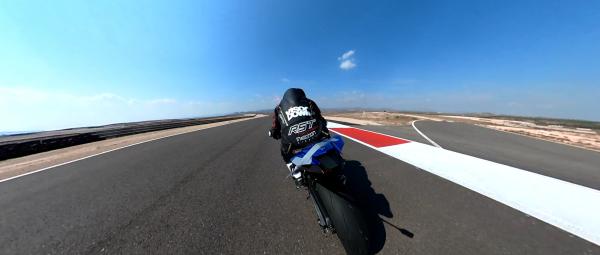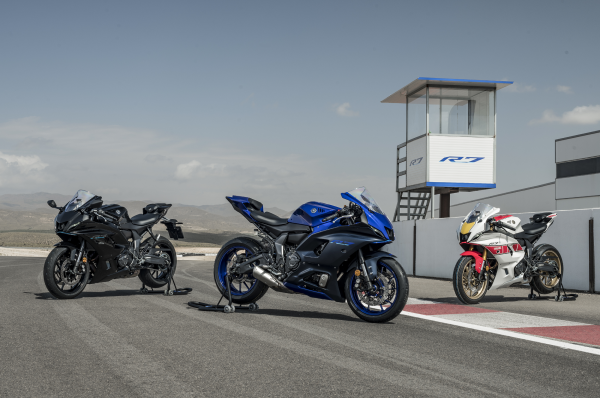Yamaha R7 (2022) review | tested on the road and on the track
We pitched the new 2022 Yamaha R7 against some of the best roads in southern Spain and the stunning Circuit Andalucía

Member for
54 years 8 monthsWITH dwindling sales in the traditional supersports segment (see Yamaha R6 and Kawasaki ZX-6R Ninja obituaries), it is clear that something needs to be done in the sub-thou faired motorcycle industry. The answer from Iwata is the svelte looking Yamaha R7, a sweet looking sports bike with the accessibility of the MT-07 and the DNA of the R1.
For the press test of this bike, Yamaha Europe had selected the roads around Almeria in Spain for the morning’s road ride, with an afternoon spent lapping the beautiful Circuit of Andalucía in the afternoon.
NEW 2022 Yamaha R7 video review
It’s the Yamaha R7, not an OWO3!
There has been a large number of people spouting off on the internet since the announcement of the new Yamaha R7 regarding the name of the little sports bike. One riled up reader wrote ‘That bike is a joke of a replacement of the original’, while another angrily vented ‘Well that’s embarrassing, bet the R7 OW02 is crying.’ I’m assuming both these posts were typed out with clenched fists and a frothing mouth.
First and foremost, this is not a replacement to the R7 of old. That bike was a homologation special built purely for WorldSBK rules that were quickly changed making it basically obsolete on the road and track. Number two. Most of the angry people getting their keyboard warrior fix have never owned an original R7 let alone swung a leg over one. Number three. What the hell did you want Yamaha to call it, The MT-07 RR? I’m pretty sure the motorcycle market has enough RR nameplates floating around already, and with the rest of the sports bike range of bikes from Iwata bearing the ‘R’ moniker, it works.
Get over it, grow up and go and panic buy some fuel, you absolute melts.
Yamaha R7 price, colours and availability
The new R7 is available in either Icon Blue (as ridden on track), Yamaha Black (as ridden on road), and the 60th Anniversary Edition. The base blue and black bike are priced at £8,200, while the 60th Anniversary bike comes in £300 more at £8,500.
Comparing that to the competition sees the Yamaha sitting around a grand more than the Kawasaki Ninja 650 (£7,349). At the other end of the scale, it comes in around £2,000 less than the more powerful and more advanced Aprilia RS660 (£10,150).
The standard bikes and the 60th Anniversary Edition will be landing in UK Yamaha dealerships in October and November 2021 respectively.
To find your nearest dealership, head to: www.yamaha-motor.eu
Yamaha R7 engine
Featuring all the changes and updates of the latest generation MT-07, the engine specs of the R7 remain largely unchanged. 72bhp arrives at 8,750rpm, while the peak torque of 49lb-ft is produced at 6,500rpm. The new Euro5 engine is one of the best parallel twins ever produced. It rewrote the rule book back in 2015 and proved at sub-100bhp twins could be exciting thanks to the innovative CP2 architecture.
Thankfully the recipe hasn’t been messed with since, and with only emissions regulations to adhere to, the CP2 is as pleasing to ride now as it was then.
An important to mention addition to the new bike is the assisted slipper clutch that does an admirable job of smoothing out downshifts and preventing any hopping on the grippy Andalucía surface. The A&S clutch also means a much lighter lever feel than is found on the MT-07 by around 30 percent.
With the shark-fin gills on the top of the tank opening up the airbox of the R7 to the world, the bike sounds more raucous than its naked sibling. The induction noise when tucked in behind the fairing is much more noticeable and opting for the Akrapovič full system will transform the bike with all the snarl and bark of a fully-fledged track machine.
Yamaha R7 chassis, suspension, and handling
To keep the R7 competitive the frame is based on the MT-07’s, although to say they are the same is unfair. An aluminium centre brace mounted on each side of the frame increases rigidity and makes a noticeable difference to the poise of the bike in faster corners. The geometry of the bike is also revised, with a shorter overall wheelbase, 1,395mm as opposed to 1,400mm, while the caster angle is reduced from 24° to 23°. These are admittedly small changes, although the R7 is a small bike and the accumulation of these updates is noticed on road and track.
One of the most welcome changes to the bike is to the suspension system, with sports bike-spec USD forks replacing the telescopic items found on the MT-07. The new 41mm KYB items feature preload, rebound and compression damping adjustability. The forks are joined by radially mounted four-pot callipers and 298mm discs. The rear shock features preload and rebound damping adjustability.
On base settings the bike does suffer slightly with Japanese test rider syndrome, meaning it’s a tad on the soft side for me although newer riders will likely welcome the more forgiving set-up. Hitting the twisties within a mile of the hotel, we get a chance to open the taps and enjoy the machine for the first time. First impressions are that the Bridgestone S22s are taking longer than expected to heat up, or maybe I’m just asking a little too much from them on the slightly polished Spanish roads!
As the route takes us further from the coast, the surface improves, the pace increases and the tyres start to come into their own. The first thing that comes to mind is just how improved the chassis is compared to the MT-07. That was always an exciting bike to ride, a bit like playing cricket with a hand grenade is an exciting game. The R7 is none of that. It has a front end that you can trust, provides accurate feedback and completely transforms the bike. The new brakes feel responsive but not overly sharp, and despite the lack of any IMU controlled ABS I was never fearful of trail-braking into corners.
I remember thinking that for this bike to really win me over, it was going to have to feel distinctly different to the MT-07. Anything less would have been disappointing. Thankfully Yamaha’s sensible updates are all in the right places. The steeper steering head angle and new front end added to the stiffer chassis and sporty riding position mean this is a true R series sports bike, more than worthy of the R7 name.
Yamaha R7 tech and equipment
Sitting front and centre in the new sleek fairing is a redesigned reverse LCD dash that is modelled on that of the flagship R1. The dash is tucked behind a small visor, although in the Spanish sun it’s still fairly tricky to read, with some of the LCD elements are obscured by the ignition key and clutch cable. The rest of the dash is fairly functional stuff, and the trip computer is all very easy to navigate. There is a nice bright shift-light dominating the top of the dash, while the rest of the warning lights and indicators are all fairly easy to see.
The Yamaha R7 also comes with the ability to hook it up to your mobile using the Yamaha MyRide app. Once done you can log your rides, check your lean angle and more.
Yamaha R7 comfort
With a riding position that is closely related to that found on the R6, the R7 is a very focused place to be. The infrequent trips we made through town on the press launch became tiresome fairly quickly, although once the road opened up again, it all clicks. The pegs are fairly high, the bars are low, and your bum is perched high on the seat. All that said, it’s not as cramped as it all sounds. Even the freakishly tall 6-foot plus journos on the launch found it to be roomy enough thanks to an ample seat to bar distance and expansive seat. As mentioned, on the track is where the riding position really comes into its own. The fairing is just about big enough to tuck behind, and the deeply scalloped flanks are just a grip-tape away from excellence.
What we like about the Yamaha R7
- All the fun of the fare without the speeding fines
- Front end feel is excellent
- Styling is pure R series
- CP2 It is still one of the best mid-size twins on the planet
What we didn’t
- LCD dash is obscured and tricky to read in the sunlight
- R-series DNA means compromised town riding
Yamaha R7 verdict
Pitched slap bang into the middle of the new breed of supersports bikes, the Yamaha R7 slots perfectly into the gap between the Aprilia RS660 and the Kawasaki Ninja 650. It’s sportier and more focused than the Kawasaki, yet slightly less advanced and cheaper than the class-leading RS660. It’s also easy to ride, perfect for new riders and looks every inch the baby R1 we all wanted.
Is it perfect? Not 100 percent, the dash needs a tweak to make it more usable and at the very limit on the track, the front end would chatter if you really pushed it. That said, you also have to look at the segment the bike is being pitched at. In truth, newer riders and those moving up from smaller bikes will likely not reach this level, not in their first year or two anyway! And should the buyer want an even more plush front end, the GYTR section of the Yamaha website has all the toys to turn your R7 into a proper track-day weapon.
b283.jpg?itok=eDDLDA3u)


f9d6.jpg?itok=wfrzIqaS)
275b.jpg?itok=BzLchX_H)
c7d9.jpg?itok=9Tqo0jlv)
734e.jpg?itok=coEd9bzg)
13bf.jpg?itok=1Bz0zaR8)
4a4e.jpg?itok=xp0FGJH8)
5ed3.jpg?itok=zmU3Q-PA)
2556.jpg?itok=SkUHVijN)
eb85.jpg?itok=WbxqGAuJ)
29ed.jpg?itok=fT20wts9)









